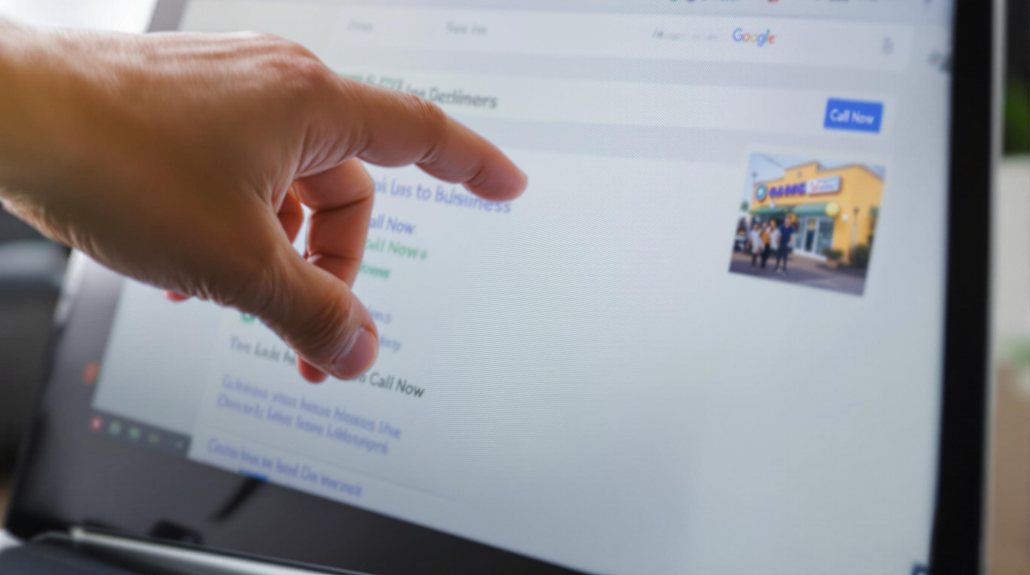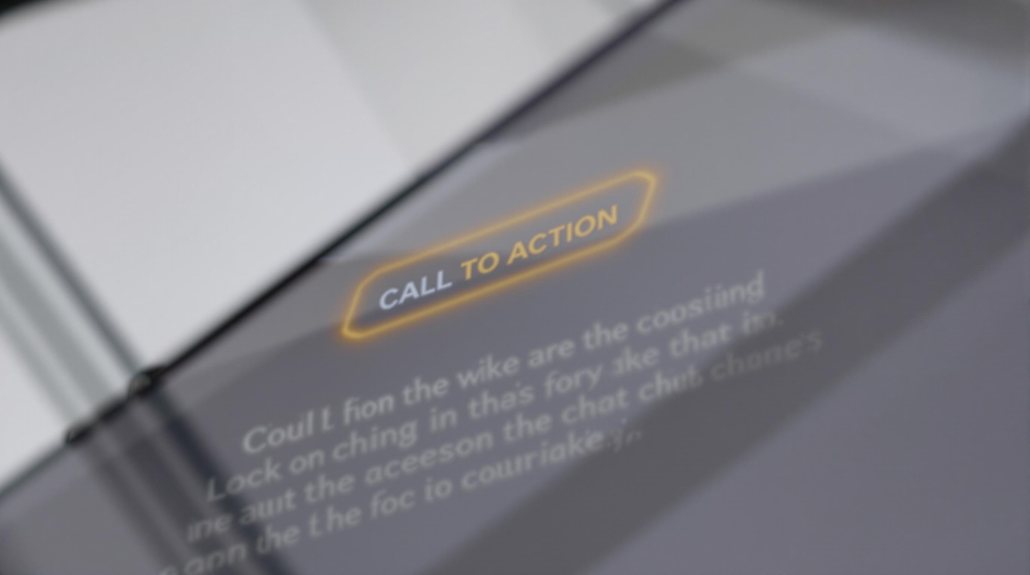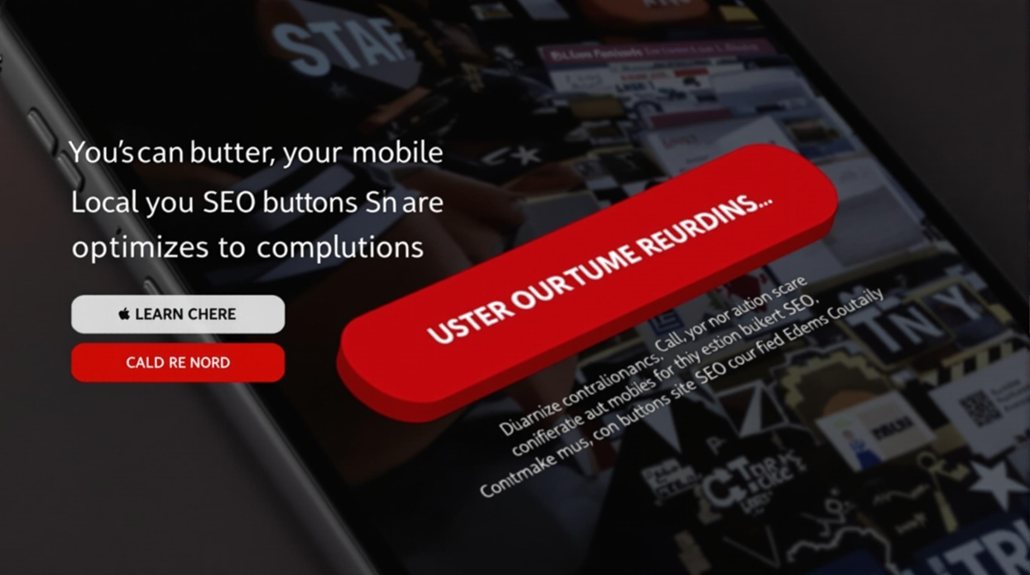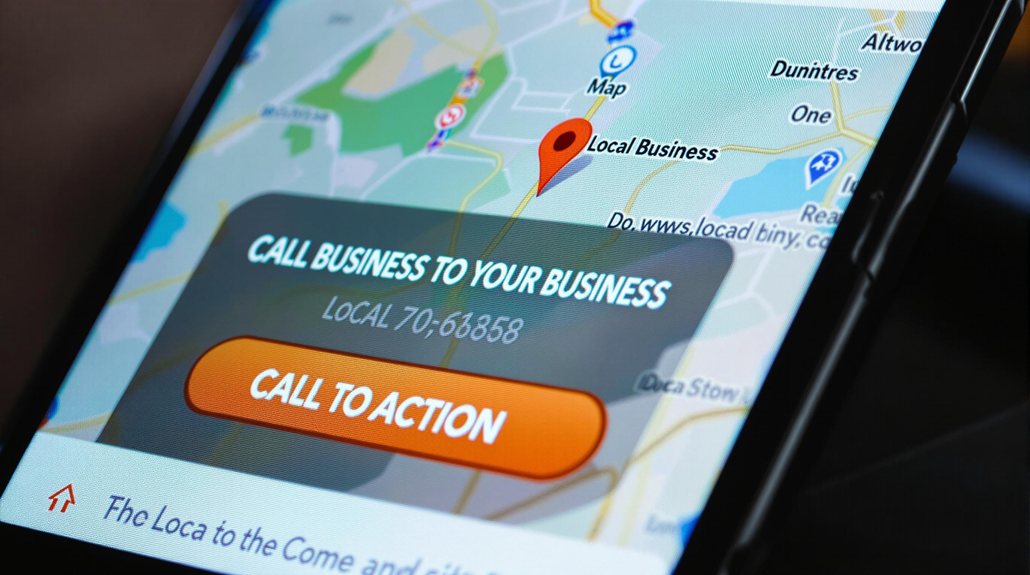To optimize calls to action (CTAs) for local SEO, start by crafting clear and compelling CTAs that use action-oriented verbs and highlight the benefits for your local audience. Strategically position your CTAs above the fold and ensure they're mobile-friendly. Create a sense of urgency with limited-time offers or deals catered to your local community. Align your CTAs with relevant local keywords, events, and cultural nuances to boost engagement and conversions. By tailoring your CTAs to your local market, you'll effectively capture their attention and drive the desired actions. Continue reading to learn more advanced strategies for optimizing your local CTAs.
Defining Clear and Compelling CTAs

When crafting clear and compelling calls-to-action (CTAs), you should start by using action-oriented verbs like "Download," "Sign up," or "Visit." Be specific in communicating the expected user action. Create a sense of urgency with CTAs like "Limited Time Offer" or "Act Now." Highlight the benefits of taking the desired action, such as "Get Discount." Additionally, use CTAs that evoke exclusivity, making users feel part of something special. Incorporate branded elements to make the CTA stand out. By following these principles, you can craft CTAs that effectively guide your local audience through the desired conversion process.
Strategically Positioning CTAs for Maximum Visibility

Placing your calls-to-action (CTAs) above the fold ensures they're readily visible to users. Optimal CTA placement can dramatically enhance local business conversions. Optimizing your CTAs for responsiveness across devices also boosts accessibility and engagement. Furthermore, strategically positioning CTAs based on a user's geographic location can enhance their relevance and effectiveness.
Above-the-Fold Placement
Strategically positioning your calls-to-action (CTAs) above the fold can significantly boost their visibility and prompt immediate action from your users. With 57% of users' viewing time dedicated to above-the-fold content, it's crucial to leverage this prime real estate. Properly placed CTAs not only enhance your SEO by avoiding penalties but can also dramatically improve conversion rates. Ensure your CTAs stand out through visual hierarchy, use compelling action-based language, and make them mobile-friendly. A/B testing and continuous content refinement will help you determine the most effective CTA placement. Regularly track conversions, click-through rates, and user engagement metrics to measure the success of your above-the-fold strategy and make data-driven improvements over time. [Optimizing above-the-fold content is particularly important for local SEO, as it can impact your visibility in local search results.
Responsive Design Optimization
Crafting responsive calls-to-action (CTAs) that adapt seamlessly across devices is paramount for maximizing their visibility and impact. Ensure cross-device compatibility by making CTAs clickable on all screens. Size them proportionally to the display for consistent appeal, and use legible typography with sufficient contrast. Maintain a uniform look across platforms to reinforce your brand. Position CTAs near intuitive navigation, within content flow, and in high engagement areas. Integrate them directly into forms and ensure visibility even when searching. Visually emphasize CTAs, use clear language, and provide instant feedback. Optimize for mobile with touch-friendly design, simplified forms, and quick load times. Leverage analytics to track performance, test variations, and refine for optimal local SEO impact. Mobile-friendly website design is a significant ranking factor for local search results.
Geo-Targeted CTA Positioning
Oftentimes, strategically positioning your geo-targeted calls-to-action (CTAs) can significantly boost their visibility and impact. Placing CTAs above the fold ensures they're immediately noticeable, while end-of-content positioning appeals to audiences who prefer detailed information before acting. Using contrasting colors makes your CTAs stand out, and incorporating action-oriented language like "Find Deals Near You Now" drives user interaction. Tailoring CTA design elements based on visitor location can further enhance CTA effectiveness. Remember to balance geo-modifiers to maintain content quality and readability. By optimizing your geo-targeted CTA placement, you can improve local search visibility, boost conversion rates, and provide a more personalized user experience.
Ensuring Mobile-Friendly CTA Design

Ensuring your CTA buttons are mobile-friendly is crucial. Position them within the "thumb zone" for easy tapping, and make sure your design is responsive to different screen sizes. Optimizing your CTA layout and appearance will enhance the user experience and increase the chances of mobile conversions.
CTA Button Placement
The strategic placement of call-to-action (CTA) buttons on mobile devices is crucial for optimizing conversions. Sticky footers and bottom placement capitalize on scrolling behavior, while frequent CTAs throughout the page engage users at different stages. Ensure thumb-friendly design and adhere to size guidelines. Leverage A/B testing to determine the most effective CTA placement, analyze user data, and continuously optimize. Maintain consistent CTA positioning across devices to enhance familiarity. Monitor key performance metrics like bounce rates to evaluate CTA effectiveness. By strategically placing CTAs, you can boost engagement and conversions on your mobile site.
Responsive CTA Design
To ensure your call-to-action (CTA) buttons are mobile-friendly, you'll need to prioritize responsive design principles. Use a simple, prominent layout that grabs users' attention. Make sure your CTAs are large enough for easy tapping on small screens. Leverage color psychology to boost appeal, and minimize visual clutter around the CTAs. Regularly test your mobile CTAs to ensure they function properly and remain visible without scrolling. Analyze metrics like click-through and conversion rates to optimize your mobile CTAs. Tailor your CTAs to the user's context and journey, offering personalized experiences that drive the desired actions. CTAs are often designed as buttons with a clear command or action phrase, which helps guide the user to take the desired action.
Crafting Concise and Action-Oriented CTA Copy
Crafting compelling call-to-action (CTA) copy is crucial for driving user engagement and conversions. Use action-oriented verbs like "discover," "learn," and "shop" to create a direct call to action. Empower readers by emphasizing action with second-person verbs. Avoid vague words that don't spur action, and use concise language to avoid confusion. Common action words include "buy," "join," and "start." Keep your messaging clear, your design minimalistic, and your copy concise. Limit CTAs to a single action to avoid confusing visitors. Utilize simple text elements like "subscribe" or "connect with us" for maximum impact. [Ensuring your CTA is optimized for local SEO can help drive more targeted traffic and conversions.
Creating a Sense of Urgency With CTAS
Why not create a sense of urgency with your call-to-action (CTA)? Emphasize scarcity, use visual cues, and offer limited-time deals. Ensure the claims are genuine to avoid appearing deceptive. Incorporate phrases like "Act now to get 50% off!" or "Grab This Limited Offer!" Highlight availability for a limited time, use countdown timers, and capitalize on events. Tailor your approach to local audiences by using location-specific language and immediate benefits. Test different urgency tactics to determine what resonates best. Remember to keep CTAs simple, clear, and prominently placed on mobile devices.
| Urgency Tactics | Strategies | Best Practices |
|---|---|---|
| Emphasize Scarcity | Use Urgency Phrases | Action-Oriented Language |
| Visual Cues | Time-Bound Offers | Prominent Placement |
| Limited-Time Offers | Countdown Timers | Legitimate Urgency |
| Geography-Specific Offers | Event-Based Offers | Visual Elements |
Aligning CTAS With Local Relevance
When optimizing calls-to-action (CTAs) for local SEO, it's crucial to align them with the relevance and context of your local audience. Use local keywords, neighborhood-specific language, and highlight community-related benefits to engage your local users. Design CTAs that match local search intent and cater to the needs of your local customers. Develop hyper-local landing pages with unique CTAs that incorporate local landmarks, events, or influencers. Encourage local engagement through CTAs that invite users to events or workshops, and leverage social media to amplify your local reach. Continuously measure, test, and optimize your local CTAs based on performance metrics and customer feedback.
Integrating Location-Specific Elements in CTAs
To further enhance the effectiveness of your local SEO efforts, you'll want to integrate location-specific elements into your calls-to-action (CTAs). This can be achieved through:
- Incorporating relevant local keywords and references to increase visibility and appeal
- Utilizing location-based promotions, discounts, or offers to incentivize conversions
- Aligning CTAs with local news, events, or cultural elements to boost relevance
- Adapting the language, currency, and social proof to match your target audience's preferences
Adapting CTAs to Respect Cultural Nuances
As you optimize your calls-to-action (CTAs) for local SEO, it's crucial to adapt them in a way that respects the cultural nuances of your target audience. Be sensitive to local customs and traditions to create more appealing and effective CTAs. Ensure your CTAs resonate emotionally with the local audience to prompt faster action. Understand the local social norms and adjust your tone and messaging accordingly to avoid cultural missteps. Experiment with subtle or direct approaches based on cultural preferences. Ultimately, make your content dynamic enough to reflect local variations in behavior and preferences, driving higher engagement and conversion rates.
Highlighting Local Value Propositions in CTAs
Effective local SEO relies on highlighting your business's unique value propositions in your calls-to-action (CTAs). Emphasize local discounts, use geographically relevant language, mention local deliveries or services, and include local social proof. For example:
- Emphasize Local Discounts: Showcase exclusive local deals to boost relevance and interest.
- Use Geographically Relevant Language: Incorporate neighborhood names and landmarks to resonate with your target audience.
- Mention Local Deliveries or Services: Highlight any specialized offerings tailored to your community.
- Include Local Social Proof: Leverage endorsements from satisfied local customers to build trust.
Leveraging these local value propositions in your CTAs can significantly improve their effectiveness and align them with your target audience's needs.
Optimizing CTA Page Load Speed
To keep your CTA pages loading quickly, minimize file sizes, optimize images and other assets, and leverage caching strategies. Reducing the overall weight of your CTA pages will improve their load speed, which is crucial for providing a positive user experience. By implementing these techniques, you can ensure your CTAs are optimized for both local SEO and fast performance.
Minimize CTA File Sizes
When optimizing page load speed for your local SEO calls-to-action (CTAs), you must prioritize minimizing the file sizes of your CTA elements. Focus on usability, streamline your code, choose lightweight libraries, and limit HTTP requests. Utilize tools like Gzip or Brotli to compress files and reduce their size.
- Ensure CTA elements are designed with minimal file size in mind without compromising user experience.
- Optimize CSS, JavaScript, and HTML files to reduce the overall page load time.
- Select libraries that offer small file sizes to minimize impact on page load speed.
- Limit the number of HTTP requests to decrease load times.
Optimize Images and Assets
Optimizing the loading speed of your CTA page doesn't stop at minimizing file sizes. Compressing images is crucial. Use tools like Photoshop to reduce image file sizes without sacrificing quality. Prefer WebP over JPEG or PNG for better compression. Eliminate unnecessary images altogether. Implement lazy loading to load images only when they're visible. Optimized images not only improve page speed but also boost your SEO rankings.
Minify your CSS, JavaScript, and HTML to remove unnecessary characters. Organize your code efficiently and use tools like CSSNano and UglifyJS for minification. Remove any unused code or functionalities to streamline page execution. Leverage browser caching and server-side caching solutions to further enhance performance.
Leverage Caching Strategies
Leveraging caching strategies is crucial for optimizing the load speed of your CTA pages. Faster page loads not only enhance user experience but also improve your SEO rankings. Utilize browser caching, Content Delivery Networks (CDNs), and server-side caching to reduce load times and boost global reach. Effective caching can lead to higher SEO rankings by optimizing site performance.
- Minify CSS and JavaScript files to reduce page load times.
- Use caching tools like WP Super Cache or Varnish Cache for efficient caching.
- Regularly update cache expiration settings to ensure content freshness.
- Caching reduces server load, maintaining site responsiveness.
Maintaining Responsive CTA Design
Crafting a responsive call-to-action (CTA) design is crucial for ensuring your website's success across various devices. Optimize your CTAs for mobile by making them easily clickable without the need for zooming. Adapt your CTAs to work seamlessly on smartphones, tablets, and desktops. Maintain proportional sizing to avoid overwhelming or being overpowered by other elements. Position your CTAs effectively, ideally in the center of mobile screens for maximum visibility. Conduct rigorous cross-device testing to ensure consistent functionality and appearance. Strategically place primary CTAs above the fold and utilize multiple CTAs on long pages. Choose high-contrast colors and readable fonts to enhance click-through rates. Implement dynamic CTA elements like hover effects and action-oriented text to engage users. Continuously optimize your CTAs through A/B testing and user feedback.
Adhering to Accessibility Guidelines for CTAs
Designing accessible call-to-action (CTA) elements is paramount to ensuring your website caters to users of all abilities. Follow these guidelines to make your CTAs more inclusive:
- Prioritize visual clarity by ensuring CTAs have sufficient contrast against the background and use colors that adhere to WCAG standards.
- Leverage semantic HTML, ARIA attributes, and descriptive alt text to aid screen reader users in understanding the purpose of your CTAs.
- Provide full keyboard accessibility, logical tab order, and active element highlighting to support users who navigate exclusively via keyboard.
- Optimize for mobile responsiveness, clear tap targets, and device gestures to accommodate users with motor impairments.
Integrating accessibility best practices with your CTA design will enhance the user experience for all visitors, while also boosting your local SEO performance.
Leveraging Analytics for CTA Performance Tracking
Tracking the performance of your call-to-action (CTA) elements is crucial for evaluating the success of your local SEO efforts. Leverage Google Analytics to analyze location data, referral traffic, user behavior metrics, and conversion metrics related to your local CTAs. Set up CTA tracking codes to monitor their individual performance. Supplement this with insights from Google Search Console, Google My Business, and local SEO tools like Local Falcon, Ahrefs, or SEMrush. By understanding how your local CTAs are performing, you can make data-driven decisions to optimize their visibility, relevance, and effectiveness in driving conversions from your local search audience.
A/B Testing and Iterating on CTA Improvements
Experiment with different CTA copy to see what resonates best with your local audience. Analyze key CTA conversion metrics like click-through and conversion rates to understand what's working. Continually iterate on your CTA design and placement to optimize local engagement and drive more qualified leads.
Experiment With CTA Copy
When experimenting with CTA copy, you'll want to focus on action-oriented language that encourages immediate action. Use verbs like "Find," "Discover," or "Get" to prompt users to take the next step. You can also incorporate local keywords, such as city names, to align with regional searches. Injecting a sense of urgency with time-sensitive elements like "Limited Time Offer" can prompt faster action. Remember to keep your CTA text straightforward and focused on a single, clear action to drive conversions.
- Use action-oriented language
- Incorporate local keywords
- Create a sense of urgency
- Ensure clarity and precision
Analyze CTA Conversion Metrics
Why is analyzing CTA conversion metrics so crucial for improving local SEO performance? Tracking key metrics like conversion rate, click-through rates, and cost per conversion allows you to identify your best-performing CTAs. Using A/B testing, you can continually optimize your CTAs by comparing versions and incorporating user feedback. Ensure your CTAs are prominent, user-friendly, and optimized for mobile. Leverage conversion tracking tools to monitor the impact on organic search traffic, customer actions, and SERP visibility. Integrating these SEO insights will help you refine your CTA strategy and maximize local lead generation. Regularly iterating on your CTAs is essential for maintaining high performance and driving more qualified traffic to your local business.
Synchronizing CTAS With Locally-Focused Content
How effectively are you synchronizing your CTAs with your locally-focused content? Ensuring your CTAs are in harmony with your local content is crucial for driving engagement and conversions. To achieve this:
- Align your CTA messaging with the regional focus of your content to build trust and resonance with your local audience.
- Optimize your CTAs for mobile to cater to the prevalent trend of local searches on-the-go.
- Regularly assess the performance of your CTAs and make data-driven adjustments to keep them effective.
- Leverage local SEO principles, such as incorporating neighborhood-specific keywords, to enhance the visibility of your locally-targeted CTAs.
